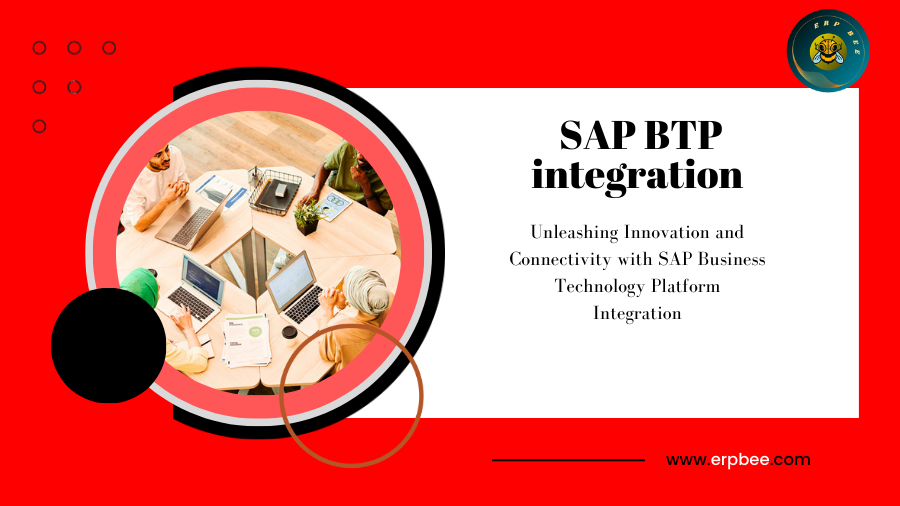Introduction: In today's interconnected business landscape, integration has become a strategic imperative. Organizations seek seamless data flow, real-time insights, and enhanced user experiences across diverse systems and applications. SAP Business Technology Platform (SAP BTP) integration emerges as a dynamic solution to bridge these gaps, empowering businesses with unprecedented connectivity and innovation. This blog explores the essence of SAP BTP integration, its significance, key components, benefits, and how it catalyzes digital transformation.
Understanding SAP BTP Integration:
SAP Business Technology Platform integration revolves around harmonizing disparate applications, data sources, and technologies into a cohesive ecosystem. It enables businesses to create a unified digital framework where information seamlessly flows, processes synchronize, and innovation thrives.
Key Components of SAP BTP Integration:
- SAP Integration Suite: The Integration Suite within SAP BTP offers a comprehensive set of tools and capabilities to connect cloud and on-premises applications, whether they are SAP or non-SAP systems. It supports a range of integration patterns, including application-to-application, business-to-business, and process orchestration.
- Data Intelligence: SAP BTP's Data Intelligence component empowers organizations to discover, manage, and integrate data from diverse sources. It facilitates data governance, quality enhancement, and ensures data availability for analytics and decision-making.
- API Management: SAP BTP's API Management allows businesses to create, manage, and expose APIs (Application Programming Interfaces) securely. This promotes collaboration, enables third-party integration, and accelerates innovation through API-based services.
- Extension Suite: SAP BTP's Extension Suite facilitates the development of custom applications, extensions, and microservices. It supports both low-code and pro-code development, enabling businesses to tailor solutions to their specific needs.
Benefits of SAP BTP Integration:
- Seamless Data Flow: SAP BTP integration eliminates data silos by enabling seamless data flow between different systems and applications. This ensures that accurate and up-to-date information is readily available across the organization, promoting data-driven decision-making.
- Real-time Insights: Integrated systems within SAP BTP provide real-time insights into various aspects of the business, such as sales, inventory, customer interactions, and more. This empowers stakeholders to make informed decisions quickly and respond promptly to changing market conditions.
- Enhanced User Experience: Integration leads to a consistent and unified user experience across different applications. Users can access and interact with data from various sources without the need to switch between systems, improving overall usability and productivity.
- Efficient Processes: SAP BTP integration streamlines business processes by automating data transfers, reducing manual interventions, and minimizing redundant data entry. This efficiency leads to faster and more accurate operations.
- Improved Collaboration: Integrated systems enable smoother collaboration among teams and departments. Information can be easily shared, and workflows can be synchronized, fostering better communication and cooperation.
- Innovation Enablement: SAP Business Technology Platform integration provides a foundation for innovation by allowing organizations to experiment with new technologies and integrate emerging tools. This enables businesses to quickly adopt and leverage the latest advancements to gain a competitive edge.
- Flexibility and Scalability: SAP BTP integration is flexible and scalable, accommodating the evolving needs of the business. New applications, data sources, and technologies can be integrated as the organization grows and changes.
- Cost Savings: Integration reduces duplication of effort and data, leading to cost savings. It streamlines processes, optimizes resource utilization, and minimizes the need for manual data reconciliation.
- Data Accuracy and Consistency: SAP Business Technology Platform integration ensures that data is consistent and accurate across various systems. This reduces the likelihood of errors and discrepancies, enhancing the reliability of business operations.
- Adaptive Decision-making: Real-time access to integrated data allows for adaptive decision-making based on current conditions. Businesses can respond swiftly to market trends, customer demands, and other external factors.
- Customer-Centricity: Integrated systems enable a holistic view of customer interactions and data. This supports personalized and effective customer engagement, leading to improved customer satisfaction and loyalty.
- Compliance and Governance: SAP Business Technology Platform integration can help ensure compliance with regulatory standards and internal policies by maintaining accurate and auditable records across systems.
- Agility and Time-to-Market: With integrated systems, businesses can bring products and services to market faster by streamlining processes and reducing delays caused by manual data handling.
- Ecosystem Connectivity: SAP Business Technology Platform integration facilitates connections with external partners, suppliers, and customers, creating an interconnected ecosystem that drives value across the supply chain.
Implementing SAP BTP Integration: Successful SAP BTP integration requires a strategic approach:
- Assessment: Identify integration needs, objectives, and key systems.
- Architecture Design: Design an integration architecture that aligns with business goals.
- Tool Selection: Choose the appropriate SAP BTP integration tools based on your requirements.
- Implementation: Configure, develop, and test integration scenarios.
- Monitoring and Maintenance: Continuously monitor, optimize, and maintain integrations.
Conclusion:
SAP Business Technology Platform integration is the compass that guides organizations toward a connected, efficient, and innovative future. By breaking down barriers between systems, enabling real-time insights, and fostering collaboration, SAP BTP integration transforms businesses into agile, data-driven enterprises. As industries continue to evolve, SAP BTP integration emerges as an enabler of digital transformation, equipping organizations with the tools they need to navigate the complexities of the modern business landscape.
